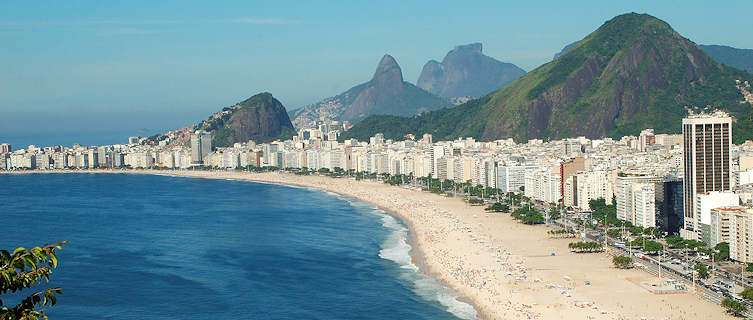
Take in the views from iconic Copacabana Beach
© iStockphoto / Thinkstock
Copacabana beaches
The huge, long sweep of Copacabana beach is one of the most famous in the world. A haunt of jetsetters from as far back as the 1920s, Copacabana continues to be a playground for the rich and famous nearly a century on. Forts stand sentinel at either end of the beach, providing pockets of history that make for interesting visits. From the sands, the iconic Sugarloaf Mountain is beautifully framed against the blue sea and kiosks dot the distinctive black and white pavement designed by Burle Marx.
The deep, sloping stretch of fine, pale sand forms a 4km-long (2.4 mile) crescent. Vendors ply the beach, loudly hawking everything from beach balls to cocktails and coconut water. The larger beachfront hotels provide a beach service for their guests, including chairs and parasols, which are also available for rent from beach stands. Skimpy bikinis are the norm, but note that topless sunbathing is illegal. Volleyball and football games are played out from morning to night, while the waters often attract surfers. Even experienced swimmers should be aware of strong currents and riptides, and follow all warnings. Eleven postos (lifeguard watchtowers) operate along Copacabana beach daily from 0800-2000, they also offer changing and toilet facilities for a charge of R$1.
The Forte de Copacabana (Avenida Atlântica, Posto 6) is a fort built in 1914 that has some interesting displays open to visitors. Adjoining it is the charming Café 18 do Forte, with good food and a lovely terrace overlooking the beach. At the other end is the hill of Morro at Leme, with another historic fort, and a scenic 'Fishermen's Walk' through untouched Atlantic Forest. The neighbourhood of Copacabana away from the beach is worth a look for its reasonably priced shops and restaurants.
There are always plenty of children on the sands, making sandcastles or playing football. On Sundays, the beach road is closed to traffic, meaning the area is much safer and more fun for little ones, as well as teenagers. Rent rollerblades or bikes, or just join the throngs of dog walkers, joggers and people promenading.
Ipanema is literally just around the corner. Its beach, fashion boutiques, eateries and bars are where the beautiful people go. Adjoining it is the very wealthy district of Leblon, with some of Rio's best restaurants. In the other direction is the must-see sight of Sugarloaf Mountain, scaled by a memorable cable car trip. Heading further north, the historic centre is awash with colonial churches, lively cultural centres and traditional museums.
The Copacabana Palace, Avenida Atlântica 1702, has hosted guests from Jayne Mansfield to Madonna. An indulgent night here is well worth the price tag. Otherwise, a taste of this grand dame's glamour can be had in one of its bars, restaurants, or in the new spa. A gin and tonic or caipirinha by the pool can be enjoyed before a sublime Italian meal at the wonderfully traditional Cipirani restaurant.
Do you have any Feedback about this page?
© 2025 Columbus Travel Media Ltd. All rights reserved. No part of this site may be reproduced without our written permission, click here for information on Columbus Content Solutions.




 You know where
You know where